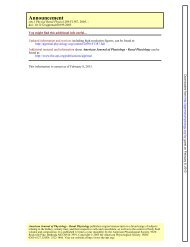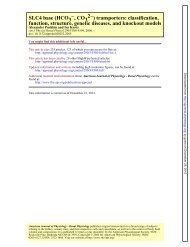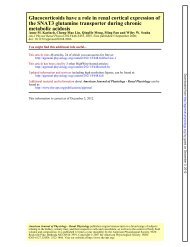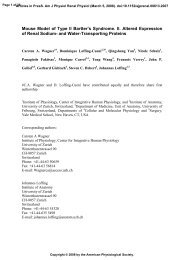Increased susceptibility of aging kidney to ... - Renal Physiology
Increased susceptibility of aging kidney to ... - Renal Physiology
Increased susceptibility of aging kidney to ... - Renal Physiology
Create successful ePaper yourself
Turn your PDF publications into a flip-book with our unique Google optimized e-Paper software.
F1276 AGING KIDNEY AND ISCHEMIC INJURY<br />
solution containing guanidinium thiocyanate. The tissue homogenate<br />
was then added <strong>to</strong> a silica-based filter that selectively binds RNA.<br />
Following washes, the purified RNA was eluted in nuclease-free H2O<br />
before being treated with DNase <strong>to</strong> remove contaminating genomic<br />
DNA. Finally, RNA quantity and purity were assessed via spectropho<strong>to</strong>metry<br />
using the A260 and A260:A280 ratio, respectively.<br />
Identification <strong>of</strong> candidate genes via microarray analysis. Microarray<br />
hybridization and scanning were performed by the Genomics Core<br />
Facility <strong>of</strong> the Center for Environmental and Rural Health at Texas<br />
A&M University. RNA that passed the Agilent Technologies 2100<br />
Bioanalyzer quality control test was used <strong>to</strong> generate biotin-labeled<br />
cRNA via a modified Eberwine RNA amplification pro<strong>to</strong>col. Labeled<br />
cRNA was applied <strong>to</strong> the CodeLink Rat Whole Genome Bioarray for<br />
18 h (GE Healthcare); four animals per group were used. After<br />
incubation, the slide was washed, stained, and scanned. Array images<br />
were processed using CodeLink s<strong>of</strong>tware. Raw Codelink data output<br />
was imported in<strong>to</strong> GeneSpring GX 7.1 (Agilent Technologies) and<br />
normalized by setting all measurements �0.01 <strong>to</strong> 0.01, normalizing<br />
each chip <strong>to</strong> the 50th percentile <strong>of</strong> all measurements taken for that<br />
chip, and normalizing each gene <strong>to</strong> the median measurement for that<br />
gene across all chips. To focus on genes with reliable measurements,<br />
the normalized data were filtered for 1) signal intensity greater than<br />
background in at least 4 <strong>of</strong> the 12 samples (based on Codelink data<br />
flags), 2) data present in at least 6 <strong>of</strong> the 12 samples (based on<br />
Codelink data flags), and 3) an average GeneSpring Control Signal in<br />
at least 3 <strong>of</strong> 4 samples per treatment group greater than the ratio <strong>of</strong> the<br />
fixed error <strong>to</strong> proportional error for that treatment group (based on<br />
base/proportional value in GeneSpring Cross-Gene Error model). To<br />
identify those genes changed by age and/or CR, a series <strong>of</strong> two-sample<br />
Welch t-tests with a Bejamini and Hochberg false discovery rate<br />
(FDR) � 0.05 and tw<strong>of</strong>old restriction filters were utilized as indicated<br />
(Fig. 1) (5). Gene annotations were acquired using the accession<br />
numbers provided with the arrays and the GeneSpider function in<br />
GeneSpring. The data discussed in this publication have been deposited<br />
in NCBIs Gene Expression Omnibus (GEO; http://www.<br />
ncbi.nlm.nih.gov/geo/) and are accessible through GEO Series accession<br />
number GSE6110.<br />
Quantitative real-time PCR. Total RNA samples were reverse<br />
transcribed <strong>to</strong> cDNA using the iScript cDNA Synthesis Kit (Bio-Rad).<br />
Quantitative real-time PCR (qPCR) was performed using the iCycler<br />
iQ real-time PCR detection system (Version 3.1; Bio-Rad) and iQ<br />
SYBR Green Supermix (Bio-Rad). Genes <strong>of</strong> interest were targeted<br />
using specific RT 2 Real-Time PCR primer sets <strong>to</strong> claudin-7, Kim-1,<br />
MMP-7, and �-actin (SuperArray). Relative mRNA quantitation was<br />
performed using the ��Ct method; �-actin being was selected as the<br />
internal control gene and Rat Universal Reference RNA (Stratagene)<br />
was selected as the calibra<strong>to</strong>r sample (19). Briefly, the quantity <strong>of</strong><br />
target gene mRNA in each experimental sample (young, aged-AL, or<br />
aged-CR) relative <strong>to</strong> the internal control gene is normalized <strong>to</strong> the<br />
calibra<strong>to</strong>r/reference sample.<br />
Western blot. Whole <strong>kidney</strong> lysates were quantified by the Bradford<br />
method and diluted <strong>to</strong> 1 �g/�l in2� sample buffer (250 mM<br />
Tris�HCl, pH 6.8, 4% SDS, 10% glycerol, 2% �-mercap<strong>to</strong>ethanol,<br />
0.006% bromophenol blue). Samples were boiled for 5 min before<br />
electrophoresis and 20 �g <strong>of</strong> protein were separated by 8% SDS-<br />
PAGE. Separated proteins were transferred on<strong>to</strong> a Hybond-ECL<br />
nitrocellulose membrane (Amersham) in transfer buffer (25 mM Tris,<br />
200 mM glycine, 20% methanol, and 1% SDS). Nonspecific binding<br />
Fig. 3. Impact <strong>of</strong> <strong>aging</strong> on renal gene expression. A: normalized Claudin-7 (Cldn-7), <strong>kidney</strong> injury molecule-1 (Kim-1), and matrix metalloproteinase-7 (MMP-7) gene<br />
expression in young, aged-AL, and aged-CR rats as assessed by microarray analysis using the CodeLink Rat Whole Genome Bioarray. Each data point represents the<br />
normalized mean intensity � SD for that gene across all arrays (4 animals). **Significant difference in aged-AL compared with young and aged-CR. B: age-related<br />
changes in the above target genes were verified by quantitative PCR. The �-actin normalized Cldn-7, Kim-1, and MMP-7 gene expression in young, aged-AL, and<br />
aged-CR rats is presented relative <strong>to</strong> the gene expression in an arbitrary reference sample (Stratagene Rat Universal Reference RNA). The values represent means �<br />
SD <strong>of</strong> relative gene expression <strong>of</strong> 8 animals per group. **Significant difference in aged-AL compared with young and aged-CR.<br />
AJP-<strong>Renal</strong> Physiol • VOL 293 • OCTOBER 2007 • www.ajprenal.org<br />
Downloaded from<br />
http://ajprenal.physiology.org/<br />
by guest on December 6, 2012








